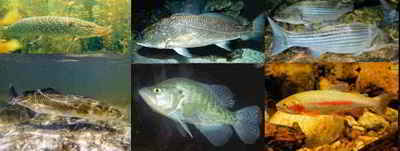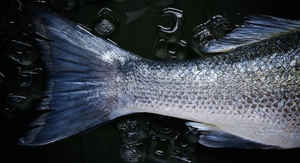Arizona State Fish
Apache Trout

(Salmo apache)
Adopted on May 6, 1986.
Arizona actually has an official state fish, adopted on May 6, 1986. It is the Apache Trout (Salmo apache). It is one of two fish native to Arizona, the other being the Gila Trout. The Apache Trout is unique to Arizona, and is not found anywhere else. It is considered an endangered species, but recent conservation efforts have allowed the state to permit some sport-fishing of the Apache Trout, within regulations defined by the Arizona Game and Fish Department.
Arizona State Fish: Apache or Arizona Trout

The Apache or Arizona Trout, (Salmo apache,) has a yellowish background color without any pink lateral banding. Its spots are pronounced and usually spaced uniformly over the body. Dorsal, pelvic, and anal fins are white or yellow tipped. The dorsal fin is proportionately larger than in most other trout species. The Latin name oncorhynchus means "hooked snout" with "Apache" indicating that it was found on the Fort Apache Reservation.
The Arizona trout originally got its scientific name Salmo apache from the salmo, which is Latin for "leaper," and Apache for the Indian reservation where it was first identified.
The Arizona trout has yellowish background coloration with dark spots uniformly over the body. The back of the fish is golden to olive brown. The fins are white or yellow tipped and there is a slash of orange to yellow on the lower jaw. It can weigh up to 6 pounds, and grows to 24 inches long.
Return of the Arizona Native Trout

Once nearing extinction, the Apache trout is now returning to its place in the legacy of Arizona's unique, native fish resources. Apache trout have been restored to much of their historic range in the White Mountains after decades of cooperative protection and recovery efforts Because the species has recovered sufficiently, anglers can now fish for them in designated state waters or on the Fort Apache Indian Reservation.This native trout is an important part of Arizona's natural heritage, and is a recreational and economic asset to the state. The Apache trout is found nowhere else in the world.;
The threat the Arizona Native Trout
Apache trout were once abundant in White Mountains in the late 1800s. Historic photos and accounts show early settlers harvesting hundreds of Apache trout in a single trip. In the early 1900s, state and federal wildlife agencies began stocking non-native trout species into the streams and lakes of the White Mountains to increase fishing opportunities for Arizona's fast-growing population. Officials believed they were addressing the problem of over-fishing in Apache trout streams and did not realize these supplemental stockings would become one of the greatest threats to Apache trout, nearly wiping them out. Nonnative trout - rainbow, brook, cutthroat, and brown - out-compete Apache trout for limited food and cover, and prey upon young native trout. Rainbow and cutthroat trout are also genetically similar and cross-breed with Apache trout, compromising the genetic purity of each species.
Location and Habitat of the Arizona Trout
Found only in White Mountain lakes and streams and are one of two trout native to Arizona. The Arizona trout is not a large fish, and thus is well suited for life in small streams. They seem to prefer small-sized streams at high elevations. The fish rely primarily on pool development, undercut banks and overhanging riparian vegetation for cover. Feeding habits of the Arizona trout seem to vary according to size. Flies are the major food for sub-adult fish, while adults feed primarily on caddis flies. Numerous land insects are also taken by all sizes of this fish.
Historically, the Apache trout occupied headwaters of the Salt, San Francisco, and Little Colorado rivers. Current distribution of natural populations is in five streams on the Fort Apache Indian Reservation and in the Apache-Sitgreaves National Forests in the White Mountains. There are also eight populations in the same area closely resembling "pure" populations, three of which occur on the Reservation. Populations have been introduced in 12 locations in the White and Pinaleno Mountains and the Kaibab Plateau. Although there is little published information about the Apache Trout, indications are that their habitat is small-sized streams at high elevations.
Arizona Laws
As a result of the statewide contest, a mammal, a reptile, a fish and an amphibian were adopted at the same time and codified under one section, titled "State animals".
The law designating the Arizona trout as the official Arizona state fish is Section 41-859 (State animals) of the Arizona Revised Statutes, Title 41 (State Government) Chapter 4.1 (HISTORY, ARCHAEOLOGY AND STATE EMBLEMS) Article 5 (State Emblems) Section 41-859
TITLE 41. STATE GOVERNMENT.
Chapter 4.1 - HISTORY, ARCHAEOLOGY AND STATE EMBLEMS.
ARTICLE 5. STATE EMBLEMS.
41-859. State animals. The ringtail or bassariscus astutus, the Arizona ridgenose rattlesnake or crotalus willardi, the Arizona trout
or salmo apache and the Arizona tree frog or hyla eximia shall be known respectively as the state mammal, reptile, fish and amphibian.
Taxonomic Hierarchy: Apache or Arizona Trout
Kingdom: Animalia - animals
Phylum: Chordata
Class: Osteichthyes
Order: Salmoniformes
Family: Salmonidae
Genus: Salmo
Species: Salmo apache








